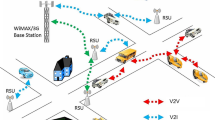Abstract
Unified judgment standards and methods are often adopted to identify traffic state in certain road network based on traffic flow parameters. However, drivers often have different perceptions about the traffic state on different road sections, since their expectations on traffic state vary more or less from each other on different road sections. In particular, under the vehicle networking, out of considerations for safety and other relevant factors, requirements for the correlation and coordination of running vehicles have also raised significantly. Therefore, it is necessary to take driver’s perception about the driving conditions of certain road sections into consideration to adjust the release of traffic state. This paper has provided a comprehensive traffic state evaluation model linked with driver’s perception under the vehicle networking. The authors first establish an ANFIS model based on the T–S model and then conduct statistical analysis on drivers’ perceptions about certain traffic state. At last, the authors use the results of statistical analysis as regulatory factors to amend the parameters input through ANFIS. Through simulation, this paper has demonstrated that the model established has a high rate of convergence, a high identification precision and the generalization ability to conduct researches on the identification of traffic state.






Similar content being viewed by others
References
Zeng H (2010) Study on video-based identification of urban road traffic congestion[D]. Chongqing University, Chongqing (in Chinese)
Sun LF (2005) Study on DSS of management of urban traffic congestion[D]. Huazhong University of Science and Technology, Wuhan (in Chinese)
Pei HR (2010) Research on cognitive-mechanism-based urban traffic regional LOS evaluation[D]. Beijing Jiaotong University, Beijing (in Chinese)
Zhang X, Shao CF, Ge ZY (2009) Study on the evaluation index system of urban transport system traffic and transportation. Urban Pub Transp 35(17):30–31 (in Chinese)
Sun C, Zhang YL (2010) Study on urban intersection traffic state evaluation based on fuzzy reasoning. Traffic Transp (z2):28–31 (in Chinese)
Long XQ, Tan YL (2011) Urban traffic congestion evaluation based on fuzzy comprehensive evaluation. Commun Stand (11): 114–117 (in Chinese)
Jang SC, Guan W (2009) A method to estimate traffic flow state of urban freeway road section. J Beijing Jiaotong Univ 33(6):47–51 (in Chinese)
Dong CJ, Shao CF, Xing ZH (2011) Identification of traffic state with optimized SVM method on urban expressway network. J Beijing Jiaotong Univ 35(6):13–16
Fu H, Xu LH, Hu G, Wang Y (2010) Traffic flow state-forecasting algorithm based on Sugeno neural fuzzy system. Control Theory Appl 27(12):1637–1640
Takagi T, Sugeno M (1985) Fuzzy identification of systems and applications to modeling and control. IEEE Trans Syst Man Cybern 15(1):116–132
Acknowledgments
The work was Supported by “the Fundamental Research Funds for the Central Universities”, No. 2013JBM055.
Author information
Authors and Affiliations
Corresponding author
Rights and permissions
About this article
Cite this article
Zhu, Gy., Lu, Gn., Yang, CG. et al. Research on the comprehensive traffic state evaluation model linked with drivers’ perception under the vehicle networking. Pers Ubiquit Comput 18, 1955–1961 (2014). https://doi.org/10.1007/s00779-014-0801-4
Received:
Accepted:
Published:
Issue Date:
DOI: https://doi.org/10.1007/s00779-014-0801-4




